|
Monday, August 2, 2010
Progress Notes
I have always had an interest in researching the history of those Miller Countians who moved away from our county to another area of the country where they became known as acquiring some degree of success in some or another area of their lives. One of those I learned about recently was a lady named Camille Nixdorf Phelan (photo 01).
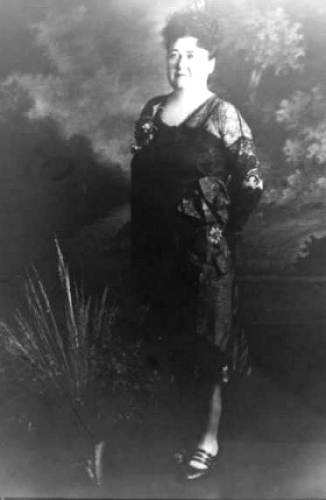
01 Camille Nixdorf Phelan She was a granddaughter of one of Miller County’s most well known physicians, Dr. Anton Paul Nixdorf (photo 02), and daughter of Anton’s son, Perry Nixdorf (photo 03), who also was a physician.
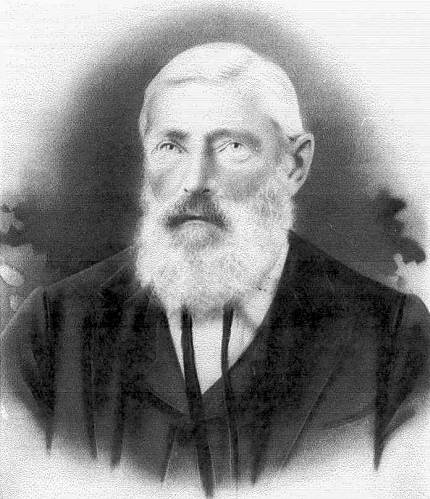
02 Anton Paul Nixdorf M.D.
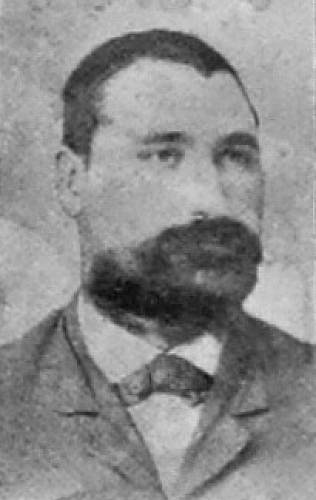
03 Perry Nixdorf M.D. Camille’s grandmother, “Minnie” (Wilhelmina Augusta Caroline Nixdorf) (photo 04) was a milliner and as the story below reveals, Camille herself had an interest in sewing and needlework.
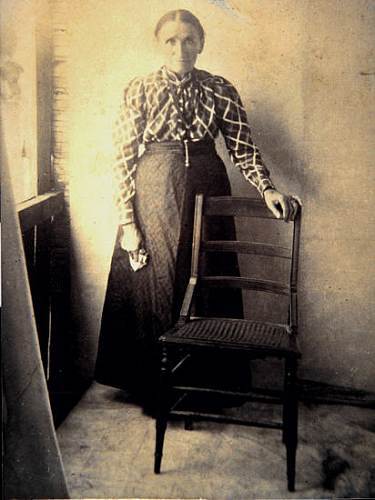
04 Wilhelmina Nixdorf Here is the story of Camille:
CAMILLE NIXDORF PHELAN (1882-1946)
Known as the designer and maker of the Oklahoma History Quilt, Camille Nixdorf, the only child of Dr. Perry T. and Nancy Nixdorf, was born on April 12, 1882, at Pleasant Farm, Miller County, Missouri. Shortly after Camille's birth her mother died, and she was sent to live with an aunt in St. Elizabeth, Missouri. Nixdorf attended the St. Joseph Academy in St. Louis where she developed her talents in art. In 1900 she married Dr. Joseph R. Phelan, and they moved to Oklahoma City in 1901.
Like other women of her social station, Camille Phelan enjoyed ornamental needlework and joined sewing clubs. Around 1927 she decided to make a quilt portraying Oklahoma history from 1541 (the year of Francisco Vasquez de Coronado's expedition through the present Oklahoma Panhandle) to about 1931. She spent two years researching the state's history, selecting prominent Oklahomans and events to be sketched on fifty-four quilt blocks. She worked four year stitching the outlines of the drawings with black silk thread and embroidering the details in pastel colors. After exhibiting her quilt at the 1933 Chicago World's Fair, Phelan donated it to the Oklahoma Historical Society in 1935 (photo 05).
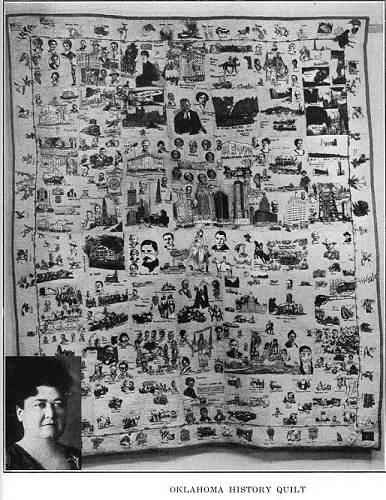
05 Oklahoma History Quilt
Click image for larger viewBefore her death on July 28, 1946, in Oklahoma City, Phelan was a member of a number of social organizations as well as the organizer and president of the Clara Barton Chapter of the Oklahoma City Red Cross.
BIBLIOGRAPHY: Aletha Caldwell Conner, The Oklahoma History Quilt (N.p.: N.p., 1935). Dorothy Cozart, "Camille Nixdorf Phelan: Oklahoma Quiltmaker," The Chronicles of Oklahoma 72 (Winter 1994-95). Daily Oklahoman (Oklahoma City), 27 December 1931 and 29 July 1946. Jane Amstutz Harnden and Pamela Frazee Woolbright, Oklahoma Heritage Quilts (Paducah, Ky.: American Quilters Society, 1990). D. W. P. [Dan W. Peery], "Oklahoma History Quilt," The Chronicles of Oklahoma 13 (December 1935). "Quilt," Vertical File, Oklahoma Room, Oklahoma Department of Libraries, Oklahoma City, Oklahoma.
Linda D. Wilson
© Oklahoma Historical Society
More about Camille’s quilt is presented in this article taken from an old edition of the Chronicles of Oklahoma:
Chronicles of Oklahoma
Volume 13, No. 4
December, 1935
OKLAHOMA HISTORY QUILT
D. W. P.
Page 472
Men in all ages have left some trace of their history. Archeologists have learned something of the antediluvians, or those people who inhabited the earth in what is usually termed the prehistoric ages. They have left their imprint in characters that have never yet been fully interpreted, although learned men have spent their lives trying to unravel the mystery story told in these strange figures engraved on stone. Histories that were written in cuneiform characters, and hieroglyphic symbols, have been translated through the aid of the Rosetta stone until the land of the Nile has given up its secrets. The annals of ancient Mesopotamia were written on clay and then baked and filed away, so even now, the research scholar can read the historical records of Babylon and Nineveh as if they were written yesterday. Cadmus, the Phoenician, invented the alphabet, or, as Carlisle has said; "The man who first invented books," and through books the history of the whole civilized world has been preserved.
Now comes an Oklahoma woman and with needle and thread has recorded the history of a great state on a quilt. It is well named the "Oklahoma History Quilt." It combines the knowledge of the historian with the genius of the artist. It portrays the history of the state vividly by artistic embroidery.
The artist and author of this historical quilt is Camille Nixdorf Phelan of Oklahoma City. On her part it has been a labor of love to produce this wonderful piece of work, with no thought whatever of financial award. The quilt is now the property of the Oklahoma Historical Society and will be placed in a substantial glass cabinet in the museum of the Society so that students of history will have the opportunity of reading the history of the state by pictographs embroidered on the quilt.
But let Mrs. Phelan tell her own story:
"Embroidering has always been my hobby. Copying pictures is another of my hobbies and I delight in reproducing on cloth with silk thread, the pictures that most appeal to me. When making quilts became a popular fad, I turned to that pastime. But—as I preferred embroidering to the seemingly foolish custom of cutting cloth up only to sew it together again, I decided that I would make an embroidered record of the persons responsible for Oklahoma's history. Then the thought came—'Why not add the incidents making up that history?' I began to assemble all the information I could find concerning this great state's early formation, beginning with white man's first appearance. Two years were spent delving into old records, writing letters to historians and in consulting the persons who actually made Oklahoma. For lack of space, I was forced to leave off many interesting incidents and to omit pictures of people who were intimately identified with early Indian Territory and Oklahoma formation.”
"My main object in making this pictured history and in presenting it to the Oklahoma Historical Society is the fact that in most of the published records of this formative period, the sordid and rough element has been exploited to the exclusion of the cultural and artistic. I want to counteract this influence by depicting the better element and to leave to posterity a record that will show the spirit of patriotism that motivated the great characters who made up the unique commonwealth Oklahoma. And I want to express my own appreciation of the 'Land of the Mistletoe,' one time domain of the proud Red Man and the inspiration of those sturdy pioneers, the 89ers, many of whom have already crossed the border in their last great run.
"In actual making, I first selected the pictures I wanted to reproduce, then I carefully sketched a replica on the cloth, reducing or enlarging it as was required to fit the space assigned it, then it was first roughly outlined with black silk thread in order to give it an outstanding effect. With needle and thread I then carefully worked in the expression—and let me tell you, this was no easy task for if a feature was out of proportion, as we will say, a nose too long for the rest of the face, the entire work had to be done over. The work was protected by a cellophane covering until the retouching of high lights was finished. This was done with soft-tinted thread as an artist uses his retouching brush on canvas. After all the figures were finished, the quilting was done. Twenty 100-yard spools of thread were used.”
"Every stitch of the embroidering is my own work and I spent all my spare time for four years in actual construction. Two years were spent in research work before I began the quilt."
The presentation of this priceless gift to the Historical Society was made an historic event. A splendid banquet was given on the night of November 30, 1935, at the Biltmore Hotel in Oklahoma City. Guests were present from many parts of the state. Some of them were men and women who had been identified with Oklahoma history for many years, while others were descendants of those sturdy pioneers who contributed to the founding of our state.
Aletha Caldwell Connor, writer and historian, served as master of ceremonies. Upon presentation of the historic quilt, Gov. E. W. Marland delivered a most gracious and appropriate address accepting the gift, not only on behalf of the Historical Society, but as spokesman for the whole people of Oklahoma.
I called Nixdorf descendent Carolyn Burks Levell, formerly of Miller County and sister of board member, Catherine Ponder, who told me that she had two old letters written in the very early 1900’s by Camille which had been sent to the Nixdorf home at Pleasant Farm. However, the family back here really had not known much about Camille’s life in Oklahoma, so maybe this story is of some interest to all the Nixdorfs’ living here nowadays. Carolyn and Catherine are great granddaughters of Dr. Nixdorf. Pleasant Farm no longer is present nor is the original Nixdorf home (photo 06).
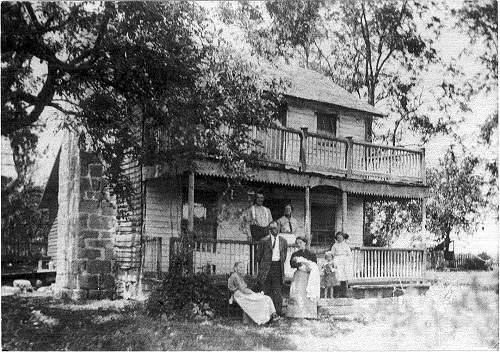
06 Dr. Nixdorf home near Ulman However, the Nixdorf cemetery is located on the old homesite near the intersection of Highways 17 and C. You can read more about Dr. Anton Nixdorf at this previous Progress Notes.
Also, if you are interested, you can read a detailed description of the historical Oklahoma sites Camille placed on each of the quilt patches at this attachment (photo 07).
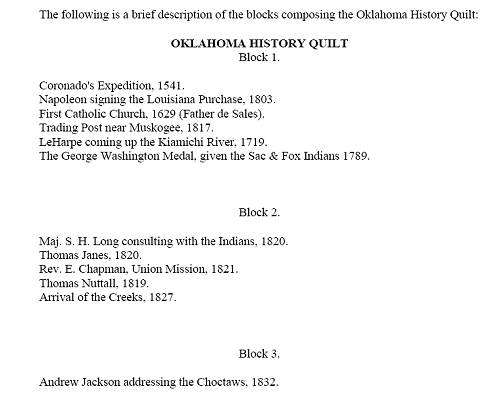
07 Oklahoma History Quilt Block Descriptions
Click image to view full PDF document
Carolyn Burks Levell (whom I mentioned above) has been a valuable resource of historical research for us regarding much of Miller County history. We were very appreciative especially of a very old map of Miller County Carolyn donated to the museum last week. This map is large enough to be a wall mount and locates old churches and one room schools across the county many of which no longer exist. Here is a photo of the map on our school room wall (photo 08) and also a photo of the map digitalized so that you can magnify it to read the small print referring to the schools and churches (photo 09).
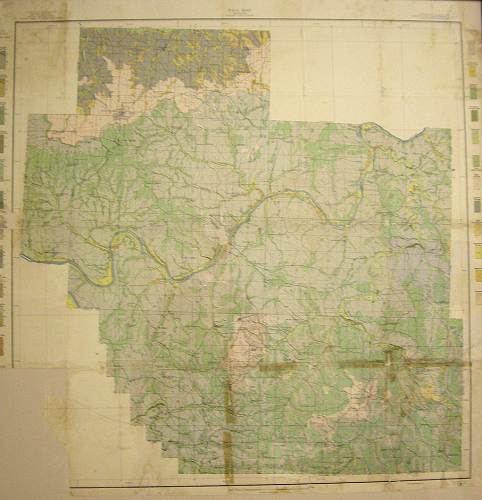
08 Miller County Map - 1912
Click image for larger view
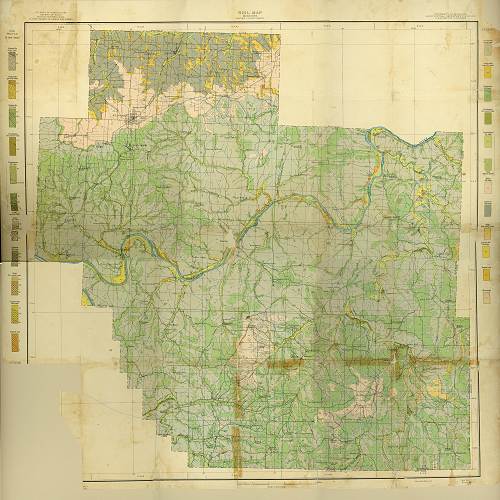
09 Miller County Map - 1912
Click image for larger viewI realize that transfer to a website may preclude readers from being able to magnify the photo sufficiently such as we can with the original digitalized version at the museum.
Peach Peeling Season
For many years my wife’s family has driven a few miles south of Tuscumbia to the Ralph Hendley (photo 10) farm to buy several cartons of the peaches he trucks in from southern Missouri.
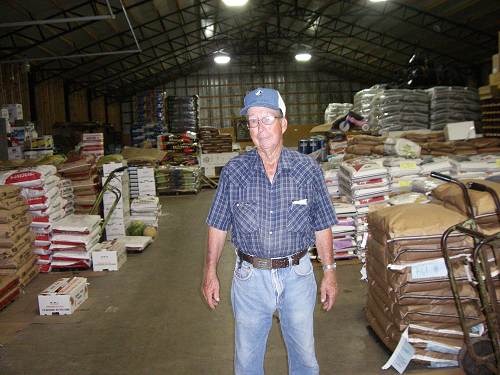
10 Ralph Hendley Ralph told me that he makes the trip himself south and buys the peaches from local orchards which he loads on his truck to bring north. My mother in law, Elva Steen, has been buying Ralph’s peaches for thirty or more years. The peaches are of much higher quality than those which are sold at local super markets and grocery stores. They are fresher and have a richer sweeter flavor than those transported from far away. Many Miller County residents through the years have discovered Ralph’s peach business which keeps him very busy during the season. In fact, when word is out that Ralph has a truck load of peaches coming in, one has to arrive at his large shed very early in the morning to get in line to have the opportunity to select the best looking peaches (photo 11).
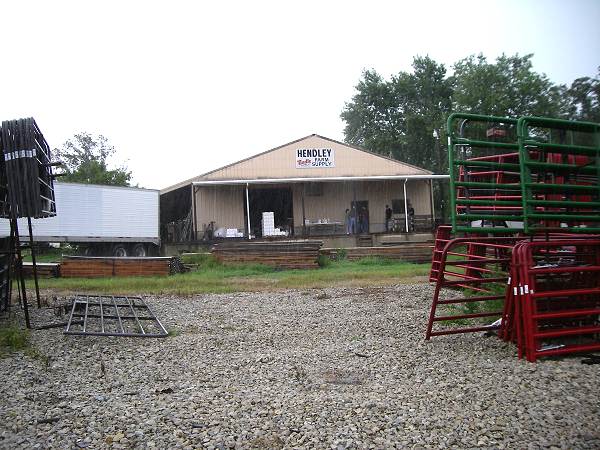
11 Hendley Farm Supply After arriving home with the peaches, the task begins of working up the peaches; cutting the peach in half, removing the seed and peeling, and cutting into the peach into slices. The peaches after being sliced are put into plastic bags for storage in the freezer. One then can enjoy Ralph’s peaches long into the winter. My wife eats them with cottage cheese. My mother in law, Elva Steen, makes extremely tasty cobblers. I eat the sliced peaches without any preparation as a snack. Here is a photo of Elva and her daughters Judy, Janie and Sharon peeling and slicing peaches they purchased from Ralph last week (photo 12):
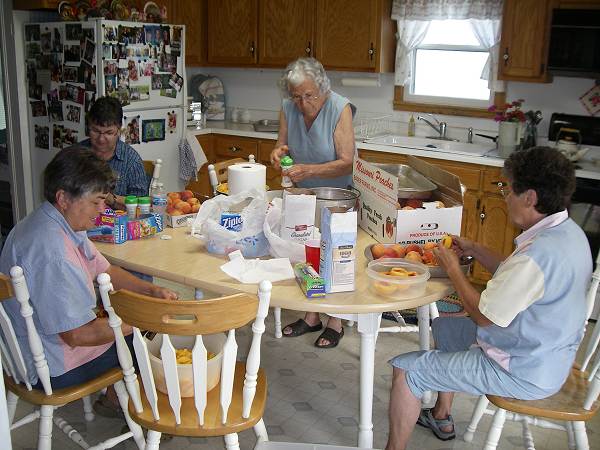
12 Peeling and Slicing Peaches I was peeling too but am not in the photo since I was the one who took the picture! Here are some of the boxes of peaches we bought (photo 13).
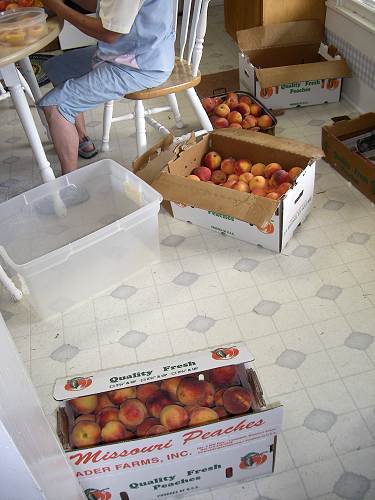
13 Peaches to be Worked Up After peeling the peaches at Elva’s house I took a photo of her home across the large field east of her house. From that distance you don’t see all the damage to the house from the hail storm I wrote about last week (photo 14).
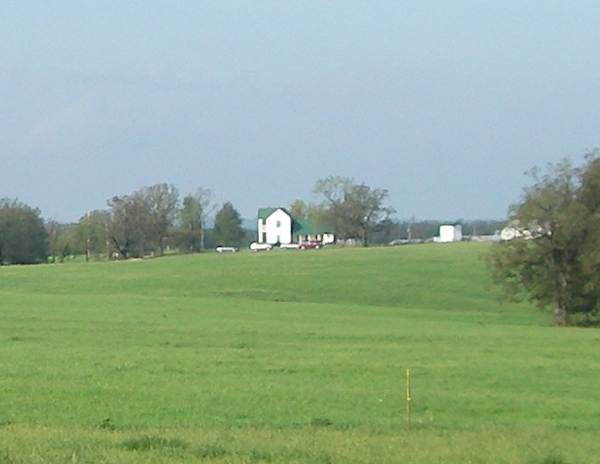
14 Steen Home However, the insurance company has been prompt she said in paying for the damage. This home is very old originally built by the old Osage River steamboat captain, John Adcock.
Ralph told me that his father, James Hendley, bought their present farm in the early 1940’s. When Ralph took over in the 1960’s, he supplemented his income by trucking pine sawdust from south Missouri to Miller County to be used by turkey farmers as litter. Soon he also was trucking in pine logs as well. Sometime in the late 1960’s he noticed the bountiful peach orchards in south Missouri and decided to truck peaches to his farm for resale to local residents. Ralph also established a livestock feed store at his farm which being centrally located between Iberia and Tuscumbia, has supplied local farmers for many years with poultry and livestock feed. Ralph said he and his family lived in Tuscumbia until he was nine years old at which time his father relocated to the present farm. He went to Pisgah School early on, but after moving the few miles south, finished school at Iberia.
The following website is a good resource for learning about some of the early Miller County communities. It is too long to print here so just go directly to the website to read it.
The new bridge across the Osage River at Tuscumbia is scheduled to be opened to the public Monday, August 16 following an opening ceremony and parade across the bridge. The parade will be lead by a marching band volunteered by Eldon High School followed by a number of cars loaned by Mike Kehoe motors of Jefferson City which will transport some Miller County senior citizens who are old enough to have crossed the first bridge at this location which was the old swinging bridge (photo 15).
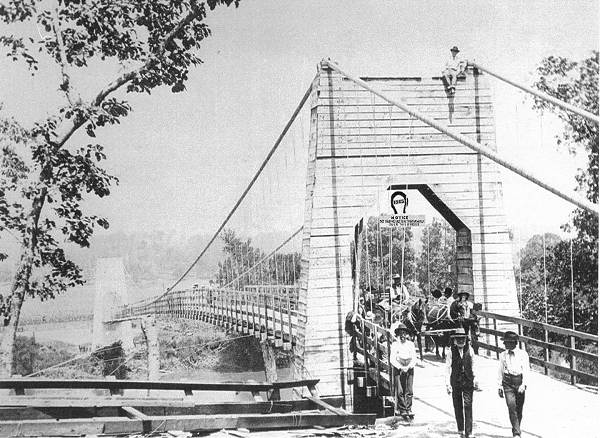
15 Tuscumbia Bridge 1905 - 1933 The parade route will continue to the Riverside Park in Tuscumbia where live musical entertainment and food will be provided. Here is a photo of the present bridge, soon to be replaced, which was taken not too many years after it was completed in 1933 (photo 16).
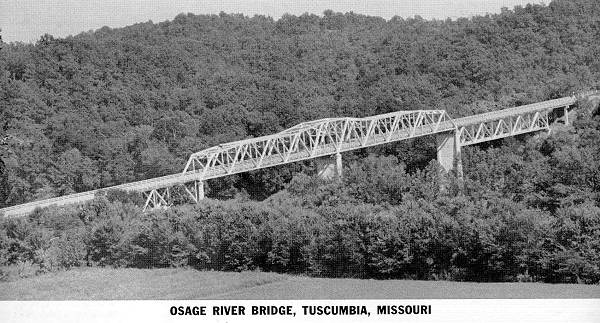
16 New Bridge at Tuscumbia - 1933 It is surprising to see how good it looked back then compared to now. And here is a photo taken the day of the 1933 celebration of the opening of the new bridge which includes the old suspension bridge too since it had not been taken down at that time (photo 17):
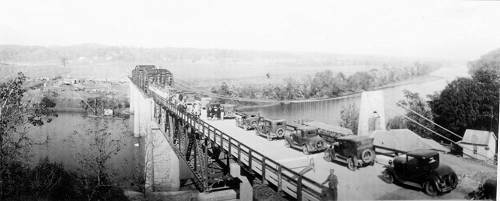
17 The 1933 and 1905 Bridges
Click image for larger viewThe stories some of the older generation residents tell of their memories crossing the old swinging bridge are interesting.
Here are some comments by Jack Edwards (photo 18) which were recorded by Ginnie Duffield in an article published in the Autogram a year ago (May 7, 2009):
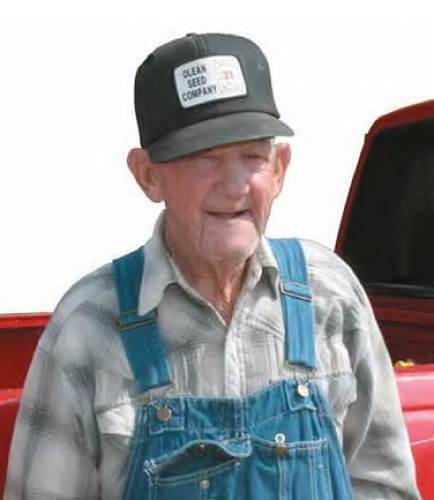
18 Jack Edwards “I rode across it with a team and a wagon...I was a little feller,” Edwards said this week. It was an exciting time for Edwards every time he went. “I got to go with my Daddy...We went to the mill every little bit,” Edwards said. The trip with the team and wagon was from the family’s river bottom farm to the old Anchor Milling Co. roller mill, located in the bottom, or “under the hill,” in Tuscumbia on the other side of the Osage River.
Horses did not like the suspension, or swinging bridge, Edwards said. “You had to make them go. They’d kind of creep across it,” he said. “When the wind was out of the east, it was awful rough. It (the bridge) would swing four or five feet,” Edwards remembers.
The bridge was a toll bridge, with a small house on the south, or upper, end. Edwards said he can remember his father “pitching the money up on the toll house porch.” He thinks the toll was a quarter.
Sadly, Jack passed away not long after the interview and did not have the opportunity to cross the new bridge which would have been the third bridge across the Osage River he would have seen.
You can read the entire interview with Jack by Ginnie at this URL of the previous Progress Notes of May 25, 2009.
Also, you can read all about the history of Osage River bridges and ferry transportation at that previous Progress Notes which has many old photos to accompany the narrative.
Another interesting narrative on our website tells the history of the 1933 bridge celebration. This is the bridge now being replaced.
Here is a photo of the pits dug at Riverside Park for the bar b cue of the pork ribs for the celebration (photo 19).
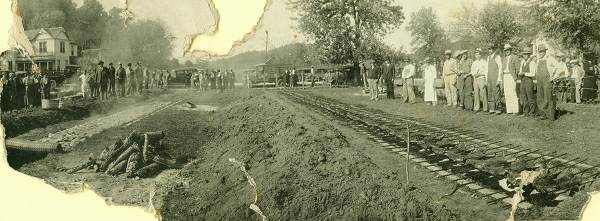
19 1933 Bridge Celebration at Riverside Park
Click image for larger viewThe home in the upper left corner was where my mother, Susie Bear Pryor, was raised. It was originally built by Phillip Hauenstein, son of William Hauenstein who started the Anchor Milling Company. The newspaper article in the Autogram about this celebration recorded an estimate of over three thousand people who attended the event.
Jack Edward’s sister, Doris Edwards Wyrick has some memories of the old swinging bridge as well which I will copy here:
Memories of the Swinging Bridge
Doris Wyrick (photo 20)
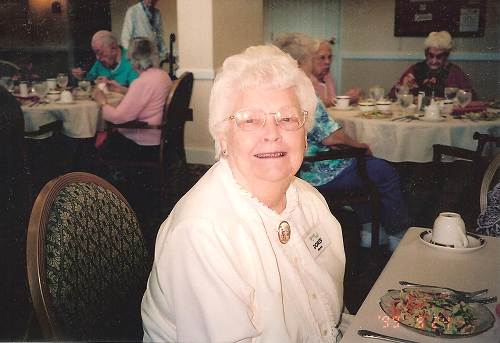
20 Doris Edwards Wyrick The Wild Mustang Horses
A long time ago, my husband, Rex Wyrick (photo 21), told me this story:
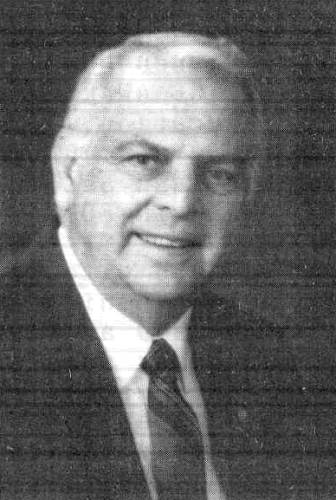
21 Rex Wyrick When the wooden swinging bridge was in use across the Osage River at Tuscumbia a young farm neighbor, Ray Watson, went to Montana to round up several wild mustang horses. He had them loaded on a train and shipped to Eldon, where the depot nearest to his farm was located. He had to drive the horses a distance of about 14 miles from the depot to his farm, which was located south of the river.
At this time, the Wyricks lived in Tuscumbia. Rex’s parents, Clyde and Gertrude Wyrick, ran the Farmers Exchange.
When the horses went through Tuscumbia Rex and two brothers that he always played with, LeRoy and Irvin Snodgrass, decided to get under the north end of the bridge to listen to the horses as they went over the wooden bridge.
I have no memory of how many horses were in the herd or of ever being told what happened to them.
In 1932, the current bridge replaced the wooden bridge and at this time (2009) a new bridge is under construction. I am now witnessing the third bridge to cross the Osage River at Tuscumbia, Missouri.
Another Bridge Story
When I was a child, we lived on an Osage River farm about five miles down river from Tuscumbia. On Saturdays my mother, Minnie Edwards, drove a Model T Ford and took all the neighbors that would fit into it to Tuscumbia to shop. One Saturday I was permitted to go along. With us that day were Aunt Letha Edwards, Aunt Etta Abbott and her two teenaged daughters, Lucy and Edna. We always dressed as if we were going to church when we went shopping.
We had to drive over the wooden toll bridge to get to Tuscumbia and to return home. I do not remember what the toll charge was or if we had to pay it both ways.
When we were returning home the wind was blowing and the bridge was shaking. Lucy’s beautiful, big brimmed new hat blew off while we were on the bridge, however it did not go off the bridge into the river. Mother stopped the car on the bridge and Lucy walked back to retrieve her hat. We were all afraid. Fortunately, no other vehicles came along. I believe it was a one-lane bridge. This happened in 1931. I was nine years old. It was very scary!
Thanks Doris.
Almost everyone who crossed the old swinging bridge remembered how it swayed back and forth even just by walking across it. Carrol McCubbin, former Miller County Representative as well as County School Superintendent, told me that in the old days his father once made a cattle drive from their farm at Brumley for a long trip to Eldon to ship cattle on the railroad to the stockyards (photo 22).
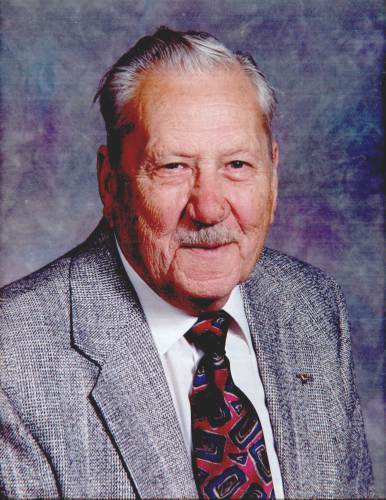
22 Carrol McCubbin The drive had to cross the Osage River at Tuscumbia by crossing the old swinging bridge. The river generally was too deep for cattle to swim across and trying to drive cattle through water is an almost impossible task anyway. Carrol told me that the old bridge immediately started swaying and swinging (after all they are called swinging bridges!) such that the cattle couldn’t keep their footing and would slide around sometimes falling to their knees. He said it was impossible for the herders to keep their feet without holding onto the cable railing. Carrol said that was the first as well as the last time they attempted a cattle crossing over the swinging bridge!
Another memory is that of Doris Wright Clemens, daughter of a previous Autogram publisher, Lawrence Wright (photo 23):
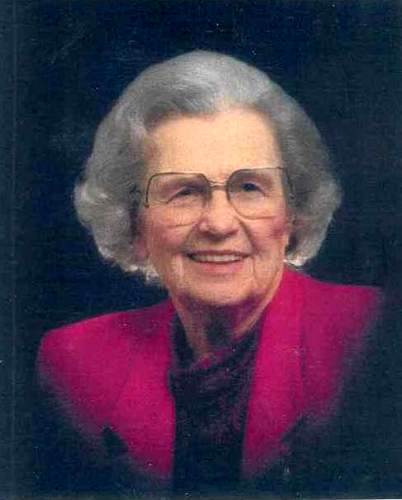
23 Doris Wright Clemens “To get to and from school (Bear School) south of the river, I walked. Sometimes my father took me in the car to the river bridge. There was a fare to cross it, so we didn't cross in the car but I walked across. The bridge was the longest suspension bridge in the state. It had its own rhythm as it hung suspended over the Osage River. A cat walking across this bridge could cause it to shake up and down until one could hardly stand up on it. Arriving at the far end of the bridge, I descended a very steep bluff on steps worn out of the rock and walked across a grassy area, flat river bottom, to the foot of a high hill. Sheltered here was the tent the Varners lived in.”
Another memory of the old Swinging Bridge is that of former Tuscumbia resident David Bear (photo 24):
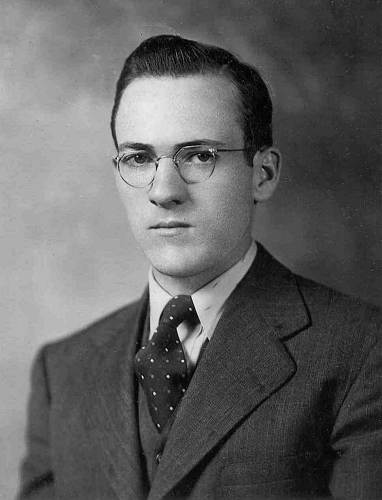
24 David Eli Bear "Rivers can be obstacles to land transportation. The early settlers had to deal with crossing streams to reach their destinations. Also the settlers on the south side of the river from Tuscumbia needed to get to town occasionally to buy and to sell. In the summer, there were usually a few shallow places where the river could be forded, but for year round transportation, a ferry was operated. The landing was near the present boat ramp in town. To do a better job of helping the public, a private corporation built a bridge in 1905. This was a suspension bridge with just one lane. In approaching the bridge, one had to watch carefully to see if someone was coming across from the other side. Once on the bridge it was difficult to back up a team of horses. The gatekeeper also helped keep watch. A toll charge was assessed for crossing. My memory is that it cost fifteen cents for a team to cross. Later, the charge was twenty five cents for automobiles.
I remember the bridge very well. It was scary for me. It would swing in the wind and the wood planks made quite a noise. It was scary to walk across because of the height from the water and the swaying of it. My brother in law, Bob Stillwell, while on summer vacation from college, helped paint the bridge one summer. All the money in Miller County couldn’t have enticed me to do that job.
Arthur Ewing was the toll keeper for many years. He lived in a shack on the south end. If he didn’t want to stay up all night, he locked the gate to keep people out. He took the proceeds to the bank weekly and always carried it in a gallon syrup bucket to camouflage his activity. Everybody knew what he was doing."
Another anecdote about the old swinging bridge was recorded by Sheldon McGowin of Ulman in his history of Ulman:
“The Ulman Milling Co. was located at the south end of town, which was last operated by Lou McCommons and Rufus Crismon. It ran day and night supplying flour and meal to its customers. The milling company was sold to the Missouri State Penitentiary and was transported to Jefferson City across the Osage River at Tuscumbia which at the time was spanned by a wooden "swinging bridge". The last load which was the steam boiler, broke through the bridge with the back tires. They had to jack the tires back onto the bridge and one of the prison trustees who was assisting with the moving, volunteered to drive the load the remainder of the way across the bridge. For this his sentence was decreased by a number of years, enough to make him a free man.”
You can read Sheldon’s history of Ulman on our website.
Last week representatives from MoDOT (Missouri Department of Transportation) met with members of Tuscumbia town officials as well as other members of the community at the high school cafeteria to discuss plans for the opening celebration (photo 25).
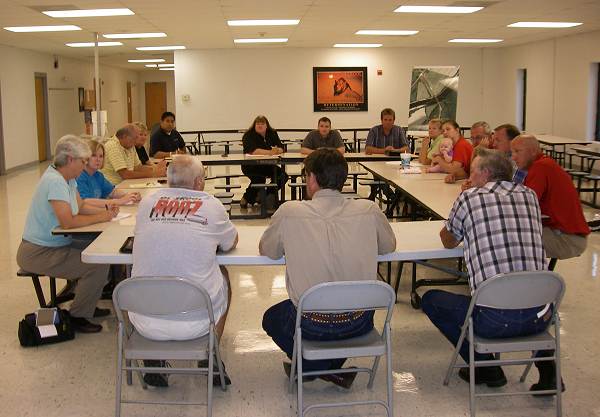
25 Tuscumbia Town Board meets with MoDOT At the rear of the photo the four representatives of MoDOT from left to right are Joab Ortiz, Kristina Jamison, Shane Peck, and Robert Lynch.
We asked the MoDOT representatives if it would be possible for the old name plates on either end of the bridge to be removed from the bridge before it is destroyed so they could be exhibited in our museum. I was told that we indeed would be given the name plates if they could be removed without breaking them. Here are some photos I took of each end of the bridge and close-ups of these old name plates (photos 26 - 29):
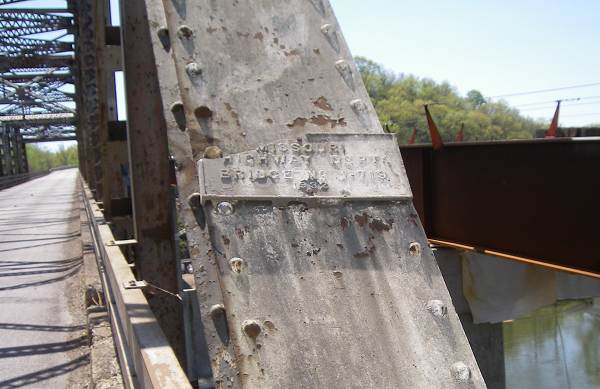
26 North end of Bridge
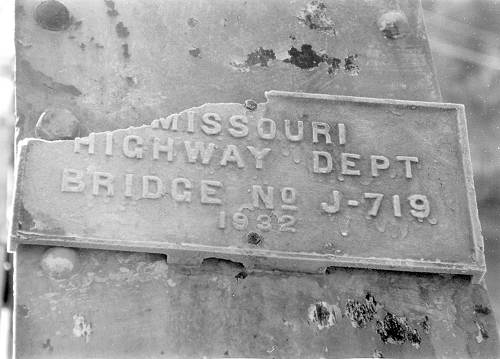
27 North Name Plate
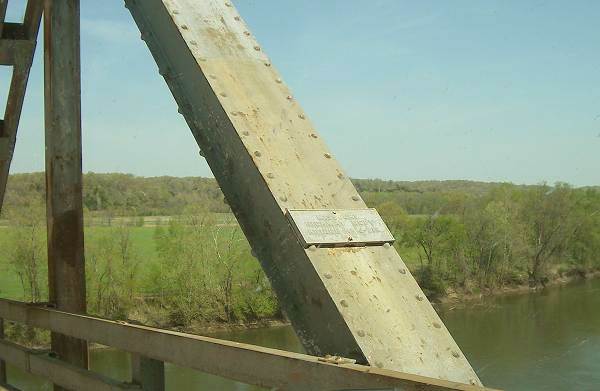
28 South end of Bridge
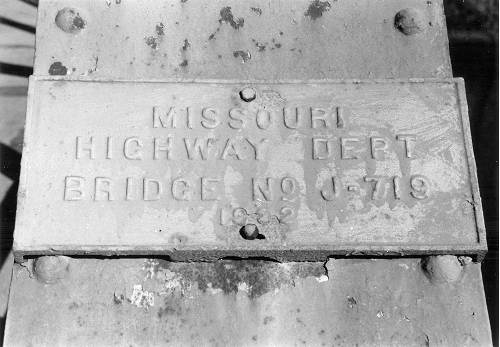
29 South Name Plate You will notice that the plates have the year 1932 recorded. However, the celebration of the opening of the bridge was in 1933 as reported in the Tuscumbia Autogram edition of Thursday, November 2, 1933.
What happened was that most of the bridge was completed in 1932 including the placement of the name plates. But some small details prolonged the official opening until November of 1933. Some readers may have noticed this alternation of the years of 1932 and 1933 as to when the bridge was built.
The hail storm we suffered two weeks ago caused more destruction than anyone can remember having occurred before in this area from hail. I wrote about the damage in the area north of Tuscumbia in the Progress Notes of that week, especially regarding the destruction caused to the homes of some of my wife’s family. Business places in the area also were damaged. One of those which may have suffered the most financially was Osage National Golf Course located on the Osage River a short distance north of the town of Bagnell. The course has been closed since the hailstorm right at the worst possible time of the year since we are now in the middle of the golfing season. Here is a letter written by Osage National director Ryan Manselle describing the situation:
Ladies and Gentlemen,
I know several of you have seen pictures of the hail damage and seen the golf course first hand right after the damage took place. Here are a couple of photos taken the day after the damage. This might help to give you an idea of what we’re working against here. These holes are about twice the size of a regular ball mark and considerably deeper in spots. We are doing our very best to get things back in working order. We will update you on the progress as we have updates.
Thanks,
Ryan Manselle
Director of Golf Operations
|
Here are the two photos to which Ryan referred (photos 30 and 31):

30 Hail Damage on Course Green

31 Hail Damage at another Course Green These hail holes would have to be repaired one by one by hand using a golf repair tool such as this one (photo 32).
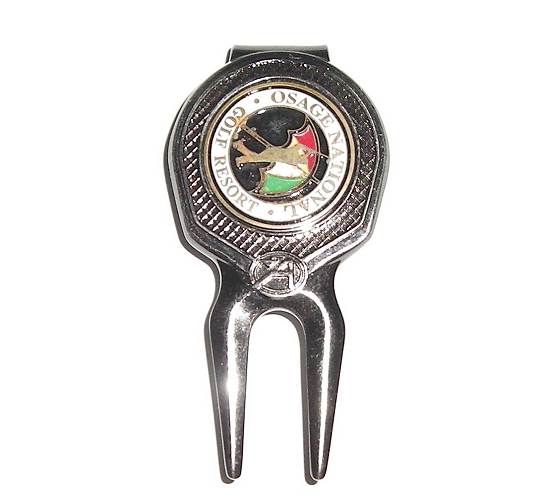
32 Ball Mark Repair Tool Such tedious work to repair every one of these holes certainly would cause a lot of sore backs from all the bending over.
For those of us who are duffers though, the thought occurred to me that if the holes had been left unrepaired we could have enjoyed the opportunity of making a “hole in one” on the par three’s for every golf shot!
Osage National has one of the best crews around for golf course maintenance and I have complete confidence that the course can be returned to its original excellently maintained condition. Members and friends also volunteered to help in the repair work over the last two weeks.
When the Osage National developers bought the land for their complex, which is located on the Osage River between Bagnell and the Highway 54 Bridge, the purchase included a farm where years before my wife Judy was born. The doctor in those days delivered at the home and Judy was born in the kitchen of the house. However, the Steen family had moved from the farm quite a number of years before Osage National bought it and the home no longer is standing.
Later, Osage National decided not to use the farm for the golf course and it was sold.
Holmes and Elva Steen, Judy’s parents, had originally come from south of the river but after WWII decided to buy this piece of land north of the river to start a turkey farm. In those days the turkeys were free ranged and not confined to the large buildings used today to raise them. After a few years on the farm the problem of frequent flooding as well as the difficulty of maneuvering turkeys on hillsides caused Holmes to decide to sell the farm and buy a ridge farm a few miles away located on Catrock Road. His wife Elva continues to live there today. Holmes passed away in 1981.
Here are a couple photos of free ranging turkeys on the Steen farm near the Osage National course taken back in the 1940’s. The first is taken of a wooded hillside including Judy’s sisters, Sue, Sharon and Shirley (photo 33).
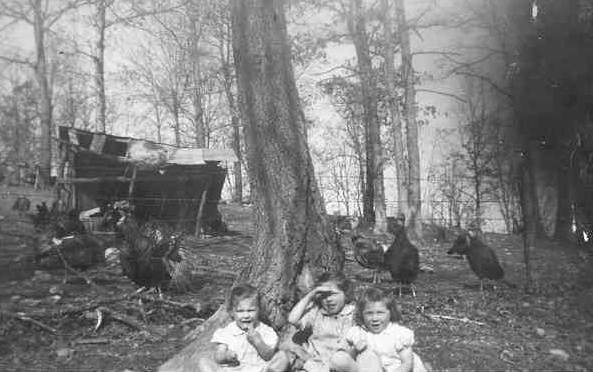
33 Sue, Sharon and Shirley with Free Ranging Turkeys The second is taken of some turkeys ranging in an open field; Holmes is holding daughter Sharon (photo 34).
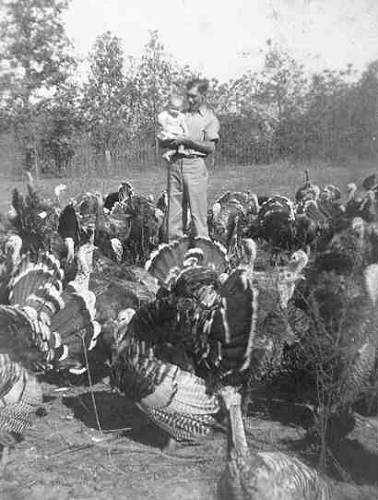
34 Holmes with daughter Sharon at Bagnell Farm - 1943 Another photo on that farm is of Judy sitting in front of the fruit/storm cellar (photo 35).
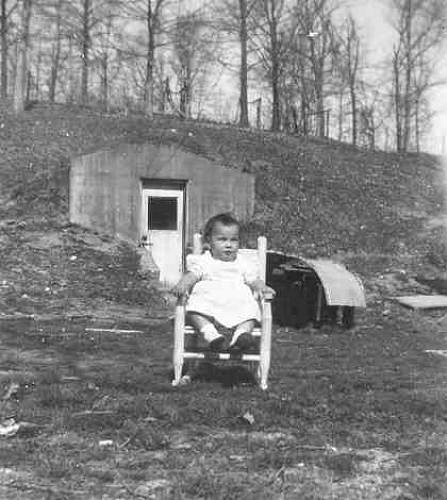
35 Judy at Bagnell Farm in front of Cellar
That’s all for this week.
 Joe Pryor
Previous article links are in a dropdown menu at the top of all of the pages.
|

